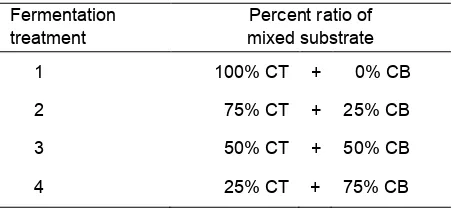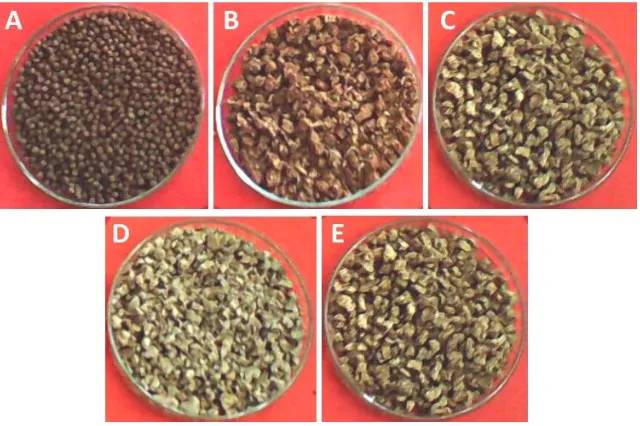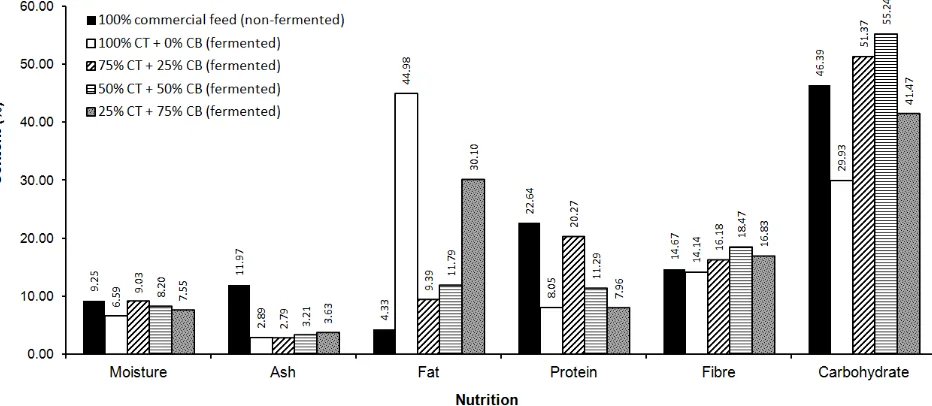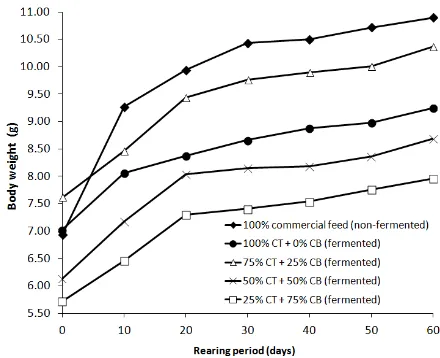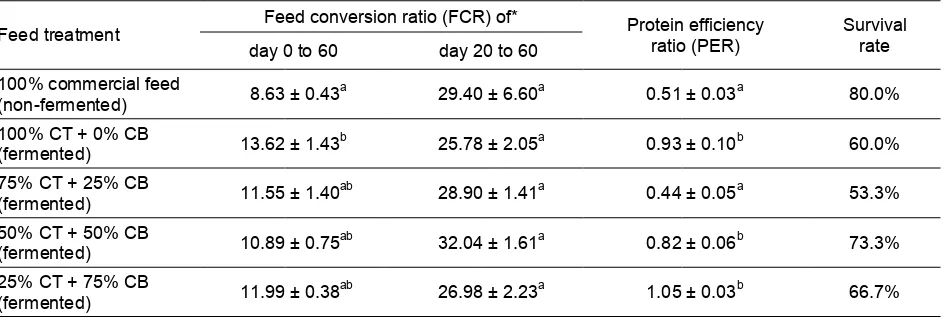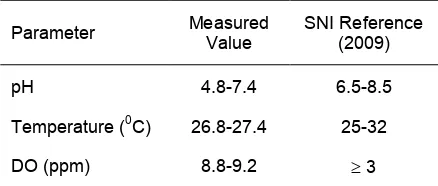JURNAL
BIOTEKNOLOGI & BIOSAINS INDONESIA
Homepage Jurnal: http://ejurnal.bppt.go.id/index.php/JBBI
GROWTH OF NILE TILAPIA (
Oreochromis niloticus
) FRY
FED WITH COCONUT TESTA-CASSAVA BAGASSE MIXED SUBSTRATE
FERMENTED BY
Rhizopus oryzae
Pertumbuhan Anakan Ikan Nila (
Oreochromis niloticus
)
yang Diberi Pakan Hasil Fermentasi Substrat Campuran Kulit Daging Buah Kelapa
dan Onggok Singkong Menggunakan
Rhizopus oryzae
Yudha Wali Pradana1, Catur Sriherwanto2,*, Etyn Yunita1, Imam Suja’i2
1
Dept. Biologi, Fakultas Sains dan Teknologi, Universitas Islam Negeri (UIN) Syarif Hidayatullah Jakarta
2
Bitechnology Laboratory, BPPT, Building 630 PUSPIPTEK Area, Tangerang Selatan, Banten 15314 *E-mail: catur.sriherwanto@bppt.go.id
ABSTRACT
Utilization of agroindustrial byproduct as cheap raw materials for aquafeed was hampered by its poor nutritional value as well as high antinutrition content which could be overcome through fermentation. Coconut testa (CT) and cassava bagasse (CB) were mixed, and fermented by Rhizopus oryzae for preparing aquafeed. Subsequent feeding test was carried out on nile tilapia fry (Oreochromis niloticus L.) in 5 feeding treatments: one unfermented feed (commercial feed 100%), and the other four feeds produced by fermentation using substrate mixture of CT and CB in 4 different ratios, namely 100%:0%, 75%:25%, 50%:50%, and 25%:75%, respectively. Feeding 100% commercial feed (true protein 22.64% and crude fibre 14.67%) showed the best results on the fish growth with body weight gain of 3.96 g and feed conversion ratio of 8.63. Meanwhile, feeding fermented feeds (true protein 7.96-20.27% and crude fiber 14.14-18.47%) resulted in body weight gain in the range of 2.22 to 2.75 g with feed conversion ratio of 10.89 to 13.62. Thus, the fermented feeds promoted growth in tested tilapias albeit less optimally than commercial feed did.
Keywords:Rhizopus oryzae, Oreochromis niloticus, coconut testa, cassava bagasse, fermentation
ABSTRAK
Pemanfaatan hasil samping agroindustri sebagai bahan pakan ikan yang murah terkendala rendahnya nutrisi dan tingginya antinutrisi yang dapat diatasi melalui fermentasi. Dalam penelitian ini, kulit daging buah kelapa (KK) dan onggok singkong (OS) dicampur dengan perbandingan tertentu, selanjutnya difermentasikan menggunakan Rhizopus oryzae untuk pakan ikan. Uji pemberian pakan dilakukan pada anakan ikan nila (Oreochromis niloticus L.) dengan 5 perlakuan: satu perlakuan pakan tanpa fermentasi (pakan komersial 100%), dan empat perlakuan pakan fermentasi substrat campuran KK dan OS dengan 4 perbandingan yang berbeda, yakni 100%:0%, 75%:25%, 50%:50%, dan 25%:75%. Pemberian pakan komersial 100% (protein sejati 22,64% dan serat kasar 14,67%) memperlihatkan hasil terbaik pada pertumbuhan ikan nila dengan pertambahan bobot badan 3,96 g dan rasio konversi pakan 8,63. Sebaliknya, pemberian pakan fermentasi (protein sejati berkisar 7,96-20,27% dan serat kasar 14,14-18,47%) menghasilkan pertambahan bobot badan ikan pada kisaran 2,22-2,75 g dengan rasio konversi pakan 10,89-13,62. Dengan demikian pakan fermentasi tersebut mendorong pertumbuhan ikan nila namun masih kurang optimal jika dibandingkan dengan pakan komersial.
INTRODUCTION
Feed makes up about 60-70% of total cost of fish production (Khasani 2013). Thus, in order to maximise profit, aquafeed utilization must be as economical as possible. In addition, technological solution that can enhance nutritional quality of abundant, cheap, and locally available feed stuffs is of highly important. Such technology would be widely adopted when highly applicable, inexpensive, and profitable to fish farmers, who are nowadays encouraged by Indonesian government policy of the so
called “aquafeed self-sufficiency” movement or GERPARI. Initiated by Indonesian Ministry of Maritime Affairs and Fisheries, this program is aimed at establishing self-sufficiency in fish feed supply by utilization of locally available resources (Direktorat Perikanan Budidaya 2016).
Bioprocessing such as solid state fermentation of agroindustrial byproducts employing the edible tempeh fungus Rhizopus spp. could be one of those appropriate technologies due to the fungus ability in enhancing nutritional qualities such as increasing protein (Canedo et al. 2016) and vitamin contents of the fermented substrates (Sriherwanto 2010), as well as reducing antinutritional components like mycotoxins (Varga et al. 2005). In addition, as the origin country of tempeh, Indonesia provides a resource for Rhizopus isolates as well as practical tempeh fermentation technology which could be adopted and further developed for animal feed production. Typically used in the making of soybean tempeh, the fungi Rhizopus spp. have been experimented in the fermentation of other various substrates rich in plant biological materials intended for fish feed constituents. These include cassava bagasse (Antika et al. 2014), coconut meal (Usman et al. 2014; Palinggi et al. 2014b), cocoa husk (Pratama et al. 2015), coffee husk (Palinggi et al. 2014a), corn cob (Kamaruddin et al. 2014), okara (Mulia et al. 2015), water hyacinth (Nugraha and Mikdarullah 2016), Sesbania grandiflora leaf powder (Utami et al. 2012), coconut bagasse (Umam et al. 2015), palm kernel cake (Amri 2007), and whole bean grains (Valdez-González et al. 2017). Some of these fermented feedstuffs were already used
experimentally either as a whole or supplemented in limited proportion in the diets of the test fishes.
In this experiment, solid state fermentation of mixed substrate consisting of coconut testa and cassava bagasse was carried out using Rhizopus oryzae as the fermenting agent to prepare floating fish feeds. The resulting fermented feeds were then fed to tilapia (Oreochromis niloticus L.) fries in order to study their effect on the fish growth. Commercial feed (Hi-Pro-Vite 781 floating feed, PT Central Proteina Prima Tbk (CP Prima) was used as control.
MATERIALS AND METHODS
Fermented feed preparation
Fermentation was carried out at the Feed Biotechnology Laboratory-BPPT, South Tangerang, Banten and the feed test in Tajurhalang, Bogor, West Java. Substrates used were rich in organic materials derived from agroindustrial activities, namely coconut testa (CT) and cassava bagasse (CB). The former consists of the thin brown skin layer clinging to the outside part of coconut (Cocos nucifera L.) meat, while the later is the solid leftover obtained from tapioca starch processing of cassava (Manihot esculenta Crant.) tuber. The two agroindustrial byproducts were mixed or combined in different ratios (Table 1), weighed out and sterilized at 121°C for 15 minutes. Having cooled down to ambient temperature, the substrates were added with inoculum powder of R. oryzae (3.3 107 cfu/g) at the concentration of 1-1.5 g/100 g substrate, and moisturized to 70% using
CIS™ mineral solution containing nitrogen,
phosphorus, sulphur, and potassium compounds. Subsequently, incubation was carried out at 28-30°C for 96-120 hours or
Table 1. Ratio of coconut testa (CT) and cassava bagasse (CB) in fermentation substrate
until the substrate was visually transformed into cottony white cake having cheese-like texture. The cake was then diced into small cubes, approximately 5 mm per side, and dried at 50°C for 24 hours. The dried fermented feeds were then analysed for its moisture, fibre, fat, ash, and carbohydrate (Badan Standardisasi Nasional 1992), as well as true protein content (Sriherwanto 2010).
Feeding test
Feeding test on tilapia fries was undertaken in a completely randomized design with three replications per treatment. Five feeding treatments were carried out, one treatment using 100% non-fermented commercial feed, and the other four treatments using feeds prepared by fermentation of mixed substrates combined in four different ratios of CT:CB, namely 100%:0%, 75%:25%, 50%:50%, and 25%:75%.
GIFT strain of Nile tilapia (Oreochromis niloticus) fries were obtained from Parung fish market, Bogor, and acclimatized for one week to feeding on the commercial feed inside aquarium environment in Tajurhalang, Bogor. Feeding was carried out three times daily, namely morning, noon, and afternoon. Half of the water volume was replaced daily with the fresh one for one week to keep the aquaria clean and reduce stress on the fishes. Post acclimatization, two month old,
5-7 g weighed fries were fasted for 24 hours, weighed out, and transferred into 35 30 30 cm glass aquaria which were placed randomly and in apparently similar positions in a shaded house. Five fishes of similar sizes were reared for 60 days in each of the 15 aquaria containing 23 L water, aerated for 24 hour.
To maintain the aqueous environment quality during the feeding test, 50% of aquarium water was replaced every day. Fish survival was observed daily, while fish body weight and length was measured 10 times: at the beginning, at the end, and every seven days of the rearing period. Water temperature, dissolved oxygen (DO), and pH values were taken at the beginning and end of the feeding experiment. Feed was given three times a day as during acclimatization with a daily dosage of 5% of the fish body weight. Fish performance was evaluated by measuring the fish weight gain, survival rate, specific growth rate, feed conversion ratio (FCR), as well as protein efficiency ratio (PER).
RESULTS AND DISCUSSION
Fermented feed
The dried feeds prepared previously by solid fermentation of combined CT-CB substrate had different colours from each others, depending on the mixing ratios of CT:CB (Figure 1). Darker colour means higher
Figure 2. Proximate nutritional content of treatment feeds consisting of commercial feed and fermented feeds based on coconut testa (CT)-cassava bagasse (CB) mixture. All values were calculated in dry weight bases (with the exception of moisture content).
proportion of CT. All of them, though, had the ability to float on water. The non-uniform shapes and sizes of the fermented feed pellets prepared by fermentation was resulted from the manual hand-cutting of the fresh fermentation cake to reduce the size into small dices prior to oven drying. The dimension of the fermented feeds was also relatively bigger than the commercial feed.
All the feeds to be used for feeding tests were analysed for their moisture, ash, fibre, true protein, fat, and carbohydrate contents (Figure 2). Results showed that, for all of the feeds, both moisture and carbohydrate contents were within the FAO recommended values (FAO 2017).
The commercial feed contained the highest concentration of ash, indicating high content of mineral. Ash contents of all of the feeds were within SNI acceptable limit of maximum 13% (SNI 2006) or less than 16% FAO recommended level (FAO 2017).
Fat content was the lowest in the commercial feed, whereas the highest value of 44.98% was found in the fermented feed using 100% CT as the substrate. This result might not be surprising as the untreated CT could contain fat ranging from 34 to 63% (Appaiah et al. 2014) or even up to 76.8% (Zhang et al. 2016). With the exception of the commercial feed, the lipid contents in all fermented feeds were above the required minimum level of 5% set by Indonesian National Standardization Agency, SNI (SNI
2006). However, FAO sets a higher standard for crude lipid, which is at least 10-15% (FAO 2017), making the fat content of the commercial feed and the fermented 75%CT+25% CB substrate feed fell below the standard value.
Amongst the fermented feeds, highest content of protein (20.27%) was found when 75% CT + 25% CB substrate combination was used as the substrate. This value was slightly lower than the commercial feed value, which was 22.64%. Different from the result of this study, the manufacturer of the commercial feed claimed the protein content to be 31-33% (Prima 2016). This nearly 10 g weight difference might be attributed to different methods of protein quantification used. Using Kjeldahl method in this study, the true protein concentration was determined based on the total nitrogen content of trichloroaetic acid-precipitated sample which eliminated non-protein nitrogen-containing compounds. Thus, the
manufacturer’s version might refer to the
crude protein contents which might inaccurately take into account all non-protein nitrogenous compounds contained in
samples, hence the term “crude”.
Figure 3. Increase of body length of tilapias (O. niloticus) fed with commercial feed or R. oryzae-fermented feeds
Figure 4. Increase of body weigth of tilapias (O. niloticus) fed with commercial feed or R. oryzae-fermented feeds
stage of its rearing period, which is adult (>200 g body weight), whereas highest protein content is required by first feeding larvae (45-50%) and broodstock (40-45%) (FAO 2017).
The fibre contents of all the feeds analysed were very similar, ranging from 14 to 17%. These values were higher than the standard maximum values required by SNI for artificial fish feed (SNI 2006) as well as the maximum 8-10% set by FAO for tilapia feed (FAO 2017).
Feeding test
As demonstrated by the profiles of body length (Figure 3) and body weight (Figure 4), all tilapias showed similar growth pattern with commercial feed treatment giving the best growth performance. This indicated the superiority of commercial feed over the fermented feed. This was confirmed also by the values of absolute and relative weight gains (Table 2). This result was expected as the commercial feed contained the highest protein content (22.64%). The second best growing tilapia was that fed with the feed containing the second highest protein content (20.27%), namely the fermented feed based on 75% CT + 25% CB mixed substrate. This confirmed the significance of protein content in aquafish, especially during early life period.
The crude fibre contents of all the feeds used in this study were unlikely to be the main cause of the difference in the growth profiles of the tilapias. This was so since the fibre contents of all the test diets were very similar (Figure 2). Crude fibre is known to be poorly
digested by fish which lacks cellulolytic activity inside its digestive tract. One of the main components of crude fibre is classified as Non-Starch Polysaccharide (NSP) which was shown to negatively effect lipid digestion and absorption in Atlantic salmon. Nutrient availability was demonstrated to be impaired when salmonids were fed with diets containing NSP (Sinha et al. 2011). Previous study demonstrated that supplementing fish diet with alpha-cellulose at the level of 25% and 40% decreased growth and feed conversion efficiency of tilapia (Oreochromis niloticus) (Anderson et al. 1984). Thus, such negative effect of crude fibre might account for the very low specific growth rate of 0.47-0.76 (Table 2) of all tilapias tested in this study compared to previously reported values (Fitriadi et al. 2015; Ali et al. 2016; Abarra et al. 2017) in which much lower fibre-containing aquafeeds were used.
FCR values varies according to nutrition and physical quality of fish feeds, as well as environmental conditions such as production intensity, temperature, availability of natural feed, and other factors like genetics (New & Wijkström 2002). Varying the diets fed to the tilapias during the whole 60-day rearing period gave different FCR values (Table 3), with those of fermented feeds being lower than that of commercial feed. This is an indication that the commercial feed promoted relatively better growth than the fermented feeds.
Table 2. Growth index of tilapia during the 60 days of rearing
Table 3. Feed conversion ratio, protein efficiency ratio and survival rate during the feeding test
Feed treatment
Feed conversion ratio (FCR) of* Protein efficiency
ratio (PER)
Survival rate day 0 to 60… day 20 to 60..
100% commercial feed
(non-fermented) 8.63 ± 0.43
a
*Mean values of the same superscript in the column show no significant difference by Tukey's post hoc test (p>0.05)
different when calculated in the period of day 20 to day 60 (Table 3). This was confirmed by the growth curves during that period which showed very similar slopes (Figure 4). This may imply that the fermented feeds could be used to replace completely the commercial feed in the later stage of the rearing period (from approximately week three to week eight). This result supports previous study in which carps were fed with fermented feeds prepared from rice bran-coconut bagasse mixed substrate (Umam et al. 2015). The authors found out that the FCRs in the week six to week eight of the fermented feeds had very close values to that of commercial feed.
Taken the values of weight gain and specific growth rate (Table 2), as well as increase in body weight profile (Figure 4), into consideration, feeding tilapias exclusively R.oryzae-fermented feeds, based on CT alone or in combination with
CB, resulted in poorer growth performance relative to those fed with the commercial feed. This could mean that fermented feed prepared from low quality agroindustrial byproducts could not be used exclusively as tilapia diet, but might be added as an ingredient or at limited inclusion level into the fish diet without adverse effect on the fish growth. This was demonstrated in previous studies, where tilapia diet could still be added at limited inclusion rates with Bacillus -fermented Jatropha curcas seed meal (Hassaan et al. 2016), yeast-fermented canola meal (Plaipetch and Yakupitiyage 2014), and Trichoderma koningii-fermented palm kernel meal (Ng et al. 2002).
PER is a term used in feed industry to assess protein quality in feed as well as effectivity reference for protein sources. PER is determined mathematically by dividing the increase in body weight of the test animal
(non-fermented) 6.94 ± 0.26
Table 4. Water quality measured during tilapia feeding experiment using the fermented feeds
with the amount of the feed protein consumed during the feeding test period (Bhilave et al. 2011). Similar to previous report on PER (Umam et al. 2015), most fermented feeds prepared in this experiment resulted in PERs which were higher than that of the commercial feed. This results imply that, although the true protein contents were lower than that of the commercial feed, the fermented feeds might contain better quality amino acid composition than the commercial one. The profile of essential amino acid of R. oryzae had been shown to be of similar quality to that of FAO standard (Hamdy 2013).
Fermented organic materials added into fish diets at certain inclusion rates were reported by previous studies to enhance PER values. For example, fermented
Leucaena leucocephala leaf powder was added as ingredient in red tilapia (Oreochromis niloticus) diets at the inclusion rates of 5%, 10% and 15%, resulting in the PERs of 1.39, 2.03, and 1.43, respectively. These values were higher than that of the control diet (unfermented L. leucocephala
leaf), which was 1.27 (Restiningtyas et al. 2015). This fermented feed supplementation seemed insignificant, but it did cause significant difference in PER values, indicating the quality of amino acid composition in the fermented samples being the possible reason. Indeed, it has been reported that DL-methionine addition into methionine-poor diets enhanced protein digestibility, body weight gain and feed efficiency of carps (Nwanna et al. 2012).
Survival rates varied amongst the fermented feed treated tilapias (Table 3), ranging from 53.3% to 73.3%, which are lower than that of commercial feed treated carps. These were below the standard values of minimum 75% (SNI 2009). Nutrient quality of the fermented feeds which was
lower than the commercial feeds might be responsible for this low survival rate.
Water quality (Table 4), including temperature and dissolved oxygen (DO) values were within the recommended values, except pH (SNI 2009). Low pH, which was below the recommended level of 6.5, might also account for the poor growth and survival rates of the tilapias, especially those fed with the fermented diets (Figure 3 and 4, Table 3).
CONCLUSION
Solid fermentation of CT-CB using R. oryzae produced floating fish feed having lower nutrition quality than that of the commercial floating feed. Tested in tilapia fish, the fermented feeds did promote growth of the fish but with poorer growth performance than that fed with the commercial feed. The former gave a specific growth rate of 0.47-0.57% (2.22-2.75 g absolute weight gain), whereas the later 0.76% (3.96 g absolute weight gain). Further studies need to be carried out using higher quality feedstuffs as fermentation substrate to obtain fermented feeds having nutritional contents, especially protein, similar to that of the commercial one. tilapia Oreochromis niloticus. Aquacult Reports 5:76–83. doi: http://dx.doi.org/ 10.1016/j.aqrep.2017.01.001
Ali TES, Martínez-Llorens S, Moñino A V, Cerdá MJ, Tomás-Vidal A (2016) Effects of weekly feeding frequency and previous ration restriction on the compensatory growth and body composition of Nile tilapia fingerlings. Egypt J Aquat Res 42:357–363. doi: http://dx.doi.org/10.1016/j.ejar.2016.06.004 Amri M (2007) Pengaruh bungkil inti sawit
fermentasi dalam pakan terhadap pertumbuhan ikan mas (Cyprinus carpio L.). J Ilmu-Ilmu Perta Indon 9:71-76
yang difermentasi dengan Rhizopus
sp. sebagai bahan baku pakan ikan nila merah (Oreochromis niloticus). J Rekayasa Teknol Budidaya Perairan 2:279-284
Appaiah P, Sunil L, Prasanth Kumar PK, Gopala Krishna AG (2014) Composition of coconut testa, coconut kernel and its oil. J Am Oil Chem Soc feeds-AAF012616W/. Accessed 15 March 2017
Canedo MS, de Paula FG, da Silva FA, Vendruscolo F (2016) Protein enrichment of brewery spent grain from Rhizopus oligosporus by solid-state fermentation. Bioprocess Biosyst Eng 39:1105–1113. doi: 10.1007/s00449-016-1587-8
Direktorat Perikanan Budidaya (2016) Harapan pada bantuan pakan mandiri. Akuakultur Indones 4:7
FAO (2017) Nile tilapia - Nutritional requirements. Food and Agriculture Organization of the United Nations. http://www.fao.org/fishery/affris/specie
s-profiles/nile-tilapia/nutritional-requirements/en/. Accessed 16 March 2017
Fitriadi R, Ekawati AW, Nursyam H (2015) Utilization of expired sausage meal as a source of protein in feed formulations for growth of tilapia Oreochromis sp. Survival 84:21
Hamdy HS (2013) Production of mini-food by Aspergillus niger, Rhizopus oryzae
and Saccharomyces cerevisiae using orange peels. Rom Biotechnol Lett 18:7929–7946
Hassaan MS, Goda AMA-S, Kumar V (2016) Evaluation of nutritive value of fermented de-oiled physic nut,
Jatropha curcas, seed meal for Nile tilapia Oreochromis niloticus
fingerlings. Aquac Nutr. doi: 10.1111/anu.12424
Kamaruddin K, Palinggi NN, Usman U (2014) Perbaikan mutu kulit kakao dan
tongkol jagung melalui fermentasi untuk bahan pakan ikan. In: Prosiding Forum Inovasi Teknologi Akuakultur pp 569–576
Khasani I (2013) Atraktan pada pakan ikan" jenis, fungsi, dan respons ikan. Media Akuakultur 8:127–133.
Mulia DS, Yulyanti E, Maryanto H, Purbamartono C (2015) Peningkatan kualitas ampas tahu sebagai bahan baku pakan ikan dengan fermentasi
Rhizopus oligosporus. Sainsteks 12:10-20 Ng W-K, Lim H-A, Lim S-L, Ibrahim C-O (2002) Nutritive value of palm kernel meal pretreated with enzyme or fermented with Trichoderma koningii
(Oudemans) as a dietary ingredient for red hybrid tilapia (Oreochromis sp.). Aquac Res 33:1199–1207. doi: 10.1046/j.1365-2109.2002.00757.x Nugraha A, Mikdarullah M (2016) Teknik
fermentasi tepung eceng gondok dengan ragi tempe sebagai alternatif bahan baku pakan ikan. Bul Tek Litkayasa Akuakultur 13:1–4
Nwanna LC, Lemme A, Metwally A, Schwarz FJ (2012) Response of common carp (Cyprinus carpio L.) to supplemental DL-methionine and different feeding strategies. Aquaculture 356:365–370 Palinggi NN, Kamaruddin K, Laining A
(2014a) Perbaikan mutu kulit kopi melalui fermentasi untuk bahan pakan ikan. In: Prosiding Forum Inovasi Teknologi Akuakultur. pp 633–637 Palinggi NN, Usman U, Kamaruddin K,
Laining A (2014b) Perbaikan mutu bungkil kopra melalui bioprocessing untuk bahan pakan ikan bandeng. J Ris Akuakultur 9:417–426
Plaipetch P, Yakupitiyage A (2014) Effect of replacing soybean meal with yeast-fermented canola meal on growth and nutrient retention of Nile tilapia,
Oreochromis niloticus (Linnaeus 1758). Aquac Res 45:1744–1753. doi: 10.1111/are.12119
Pratama A, Santoso L, Wardiyanto (2015) Fermentasi kulit kakao (Theobroma cacao) sebagai bahan baku pakan lele sangkuriang (Clarias gariepinus). J Rekayasa Teknol Budidaya Perairan 3:375-381
(CP Prima). http://www.cpp.co.id/id/ our-business/feed-business/fish/hi-pro-vite-781-pakan-ikan-lele. Accessed 16 March 2017
Restiningtyas R, Subandiyono, Pinandoyo (2015) Pemanfaatan tepung daun lamtoro (Laucaena gluca) yang telah difermentasikan dalam pakan buatan terhadap pertumbuhan benih ikan nila merah (Oreochromis niloticus). J Aquac Manag Technol 4:26–34
SNI (2006) Pakan buatan untuk ikan nila (Oreochromis spp) pada budidaya intensif. Standard Nasional Indonesia, SNI: 01-7242-2006
SNI (2009) Produksi ikan nila (Oreochromis niloticus Bleeker) kelas pembesaran di kolam air tenang. Standard Nasional Indonesia, SNI 7550:2009
Sriherwanto C (2010) Studies on the Solid State Fermentation of Cassava Bagasse for Animal Feed. Dissertation. Universität Hamburg, Germany
Umam RD, Sriherwanto C, Yunita E, Suja’i I
(2015) Growth of carp (Cyprinus carpio L.) fed with rice bran-coconut bagasse mixed substrate fermented using Rhizopus oryzae. J Bioteknol Biosains Indones 2:81–87
Usman U, Laining A, Kamaruddin K (2014) Fermentasi bungkil kopra dengan
Rhizopus sp. dan pemanfaatannya dalam pakan pembesaran ikan bandeng di tambak. J Ris Akuakultur 9:427–437
Utami IK, Haetami K, others (2012) Pengaruh penggunaan tepung daun turi hasil fermentasi dalam pakan buatan terhadap pertumbuhan benih bawal air tawar (Colossomamac ropomum Cuvier). J Perikanan Kelautan 3:191-199
Valdez-González F, Gutiérrez-Dorado R, Hernández-Llamas A, García-Ulloa M, Sánchez-Magaña L, Cuevas-Rodríguez B, Cuevas-Rodríguez-González H (2017) Bioprocessing of common beans in diets for tilapia. In vivo digestibility and antinutritional factors. J Sci Food Agric doi: 10.1002/jsfa.8275 Varga J, Péteri Z, Tábori K, Téren J,
Vágvölgyi C (2005) Degradation of ochratoxin A and other mycotoxins by Rhizopus isolates. Int J Food Microbiol 99:321–328
